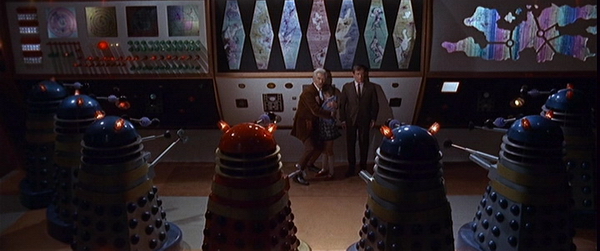Dr Who and the Daleks
UIn 1963, William Hartnell appeared on TV screens in the UK as the first incarnation of Dr Who. No-one at the time could have possibly guessed how many doctors would follow him, thanks to the clever process of regeneration. Currently, the young Matt Smith is enjoying playing the eleventh doctor in the long-running sci-fi series.
But has there really been eleven doctors? The short answer is of course no. In 1965 Peter Cushing played the time-travelling doctor on the big screen (during Hartnell's tenure on TV), facing his deadliest foe the Daleks. What made this encounter so intriguing at the time was that it was the first Dr Who adventure in colour. It doesn't seem a big deal now, but if you consider that the TV show could only be viewed on tiny, square TV's in black and white at the time, it was quite impressive.
The Doctor (Cushing) lives with his two granddaughters, the young Susan (Roberta Tovey) and Barbara (Jennie Linden). Barbara has invited her boyfriend Ian (Roy Castle) to the house for the first time to meet the family.
The Doctor decides to show Ian around and invites him into his police box in the garden. But it is no ordinary police box; it is of course, the TARDIS, a time machine.
Once inside, the four of them are accidentally transported to another world. As they set about exploring this seemingly dead planet, they come across a city. After nosing around within it, they realise that it is run by a race known as the Daleks, and they're none too friendly. In fact it appears that the Doctor and his companions timing couldn't be worse as the Daleks have every intention of blowing the planet up, with everyone on it.

It's at times like these I wish we had a flight of stairs to run up!
Although die-hard Whovians may get a bit snooty about the inclusion of Cushing as a bone fide Doctor, after all this film – and its sequel – had nothing to do with the BBC series, he actually spent more screen time as the Doctor than Paul McGann did in his one-off film stint in 1996, so there's validity right there if you need it.
Cushing certainly brings a lot of charm to the role, and certainly comes across far warmer than the original Hartnell did with his somewhat grumpy take on the character. And then you have the beauty of seeing the Daleks in both wide screen and colour, which still manages to impress in this lovingly restored version.
Director Gordon Flemyng (who directed both early big screen outings) did well with the relatively small budget at his disposal. One of the quirkier elements he brought to the series was an insight to the Daleks' love for interior design, as they appear to be fans of lava lamps, which they have dotted around their city. He drops the ball somewhat with the interior of the TARDIS which comes across as a right old mess, full of wires all over the place and a rocking chair for the Doctor.
The story itself looks and feels a little like an old Star Trek episode, with its dodgy set design and pale skinned 'alien' race, as well as its slow pacing – but let's face it, you can't rush a Dalek – but it also has a wonderfully sci-fi, retro-ness about it that's hard to dislike.
With this year celebrating the 50th anniversary of the ever changing timelord, this release (as well as its sequel Daleks' Invasion Earth 2150 A.D. also released now) are a timely reminder that Cushing was indeed the Doctor, and on this evidence, totally deserves to be recognised as such.
